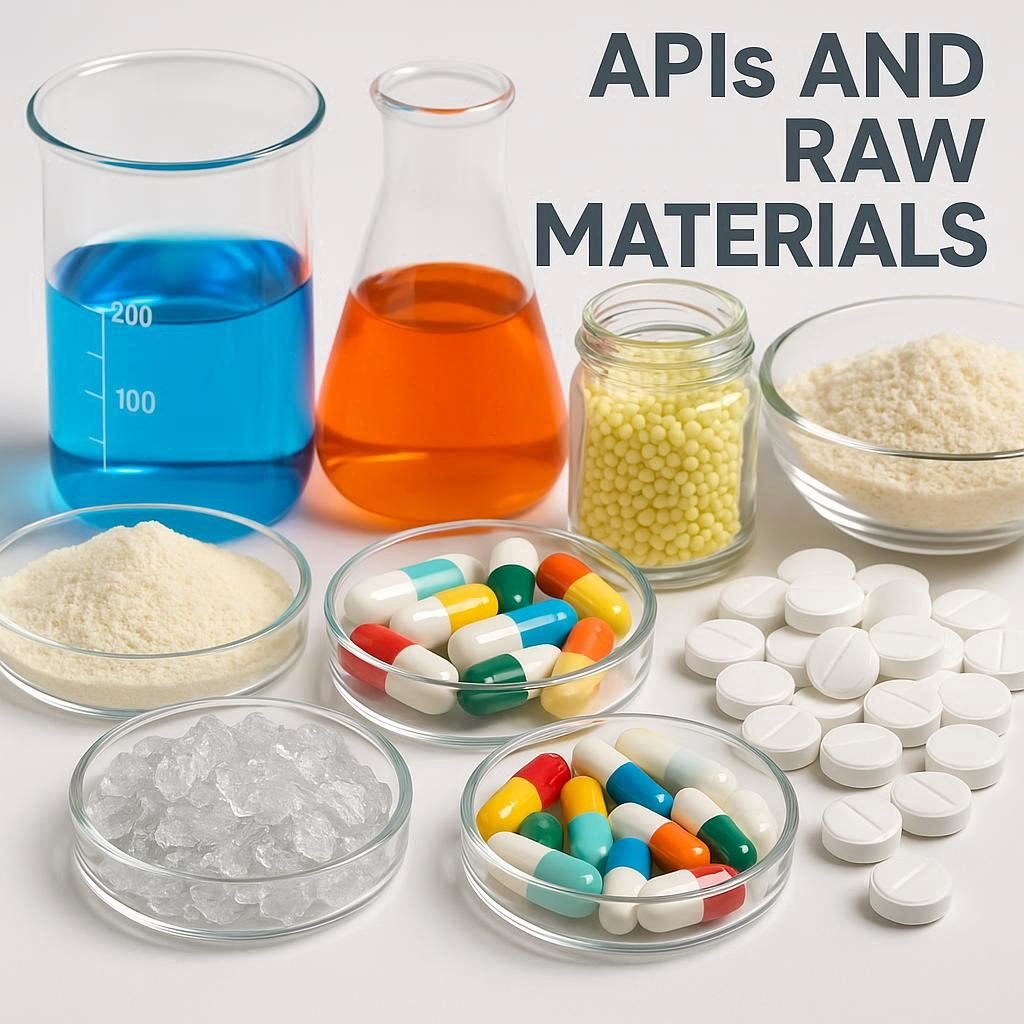
Active Pharmaceutical Ingredients (APIs) are the biologically active components of a drug responsible for its therapeutic effect. They are synthesised from raw materials through complex chemical processes. In the final drug product, APIs are combined with excipients—inactive substances that aid in the delivery and stability of the drug but have no therapeutic effect Active Pharmaceutical […]
Active Pharmaceutical Ingredients (APIs) are the biologically active components of a drug responsible for its therapeutic effect. They are synthesised from raw materials through complex chemical processes. In the final drug product, APIs are combined with excipients—inactive substances that aid in the delivery and stability of the drug but have no therapeutic effect
| Aspect | API (Active Pharmaceutical Ingredient) | Raw Material |
|---|---|---|
| Definition | The active component that produces the desired therapeutic effect in a drug. | Substances used in the synthesis or formulation of APIs or drug products. |
| Function | Provides pharmacological activity (treats/prevents disease). | Supports API synthesis or drug formulation (e.g., solvents, reagents, excipients). |
| Presence in Final Product | Present in the final drug product. | Usually not present (except excipients); used during production stages. |
| Therapeutic Effect | Yes – directly responsible for the drug’s intended effect. | No – does not have therapeutic properties (unless it’s an excipient). |
| Stage of Use | Final stage – part of the finished dosage form (tablet, injection, etc.). | Initial or intermediate stage – before or during API production. |
| Examples | Paracetamol, Ibuprofen, Amoxicillin | Acetic acid, solvents, binders, starch, lactose |
| Regulatory Control | Strict regulatory scrutiny (e.g., FDA, EMA) | Moderate regulation, especially under GMP standards |
| Purity Requirements | Very high – must meet pharmacopeial standards | Must meet manufacturing standards (not always pharmacopoeial) |
| Quality Testing | Extensive – includes potency, stability, and impurity testing | Basic testing for identity and purity; less rigorous than APIs |
| Manufacturing Complexity | Typically involves complex synthesis or extraction processes | Simpler – may be chemically basic or widely available materials |
You May Like
APIs are the active components that provide the drug’s therapeutic effect, while raw materials are the substances (like chemicals, solvents, and excipients) used to make APIs or formulate the final product.
APIs are the biologically active components in a medicine that produce the intended therapeutic effect.
Raw materials in pharma are substances used in the production of APIs or drug formulations, including solvents, reagents, intermediates, and excipients.
1. Active ingredients (APIs)
2. Excipients (binders, fillers, etc.)
3. Solvents
4. Reagents & Catalysts
5. Packaging materials
6. Intermediates
Raw material testing involves analyzing incoming materials for identity, purity, and quality to ensure they meet required standards before use in manufacturing.
Paracetamol, Ibuprofen, Amoxicillin, Metformin, Atorvastatin, Omeprazole, etc.
Lactose (excipient), Acetic acid (solvent), Ethanol (solvent), Magnesium stearate (lubricant), Corn starch (binder), Sodium hydroxide (pH adjuster), etc.
API stands for Active Pharmaceutical Ingredient.
An API is the active component in a drug responsible for its therapeutic action. It is essential because it provides the actual treatment effect in medicines.
The following are the top 10 APIs based on common use globally:
No. APIs are the final active substances, while raw materials are the building blocks used during the manufacturing process. They serve different purposes.
Yes. APIs are synthesized or extracted using raw materials through chemical, biological, or physical processes.
Yes. The API is the active component in the final product (e.g., tablet, injection) responsible for the drug’s effect.
Some raw materials, such as excipients (binders, fillers, etc.), are present in the final drug. Others, like solvents or reagents, are used during processing and removed.
Yes. APIs undergo strict regulatory scrutiny for purity, potency, and safety, while raw materials are also regulated but generally to a lesser extent.
Understanding the difference ensures quality control, regulatory compliance, and proper manufacturing workflows in pharmaceutical production.
Yes. Excipients are a type of raw material added to drug formulations to aid in processing or drug delivery, but they do not provide therapeutic effects.
Yes. All raw materials must undergo quality testing to ensure they meet specifications before being used in API or drug manufacturing.
Raw materials often form a major portion of the production cost of APIs. Their quality, availability, and price significantly impact the cost and scalability of pharmaceutical products.
| Substance | API or Raw Material? | Why? |
|---|---|---|
| Ibuprofen | API | Provides therapeutic effect (pain relief). |
| Ethanol | Raw Material | Used as a solvent in the manufacturing process. |
| Microcrystalline cellulose | Raw Material (Exipient) | Helps form the tablet but has no therapeutic action. |
Further Reading
Quick Links